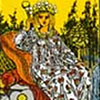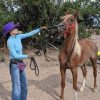Zum loves to be in my space all the time. Also, when I lead him with a lead rope, his natural response is to resist pressure or to stiffen up and refuse to move. A bad trainer resists back. Then, the colt becomes frightened and resists harder. A bad trainer uses an ever increasing level of fear and pain to control behavior. Pain is used as the motivator and punishment is a bad trainer’s tool. Punishment used after behavior is terrible timing, only negatively reinforcing bad behavior. Why punish a young colt like Zum? I need him to learn that he doesn’t need to be on top of me all the time but if I punish him, he may stop coming to greet me when I show up. Punishment produces bad side effects. With punishment, my colt may start to pace in his corral. He could become aggressive and begin to kick or lunge at me. All trust would be lost between us and he would begin to hate me. Punching, whipping, shanking and hitting a horse crosses the line into abuse. Good trainers shift away from punishment. Instead of punishment, I can use well-timed and well-applied reinforcers. I want to teach my colt to move away from pressure. I can touch his ribs and ask him to move away. I can raise my elbow if Zum tries to crowd me. Good training is preventative. If I get my colt’s feet busy and get him to focus back on me and his lesson, I can get him to relax and prevent bad behavior in the future.












